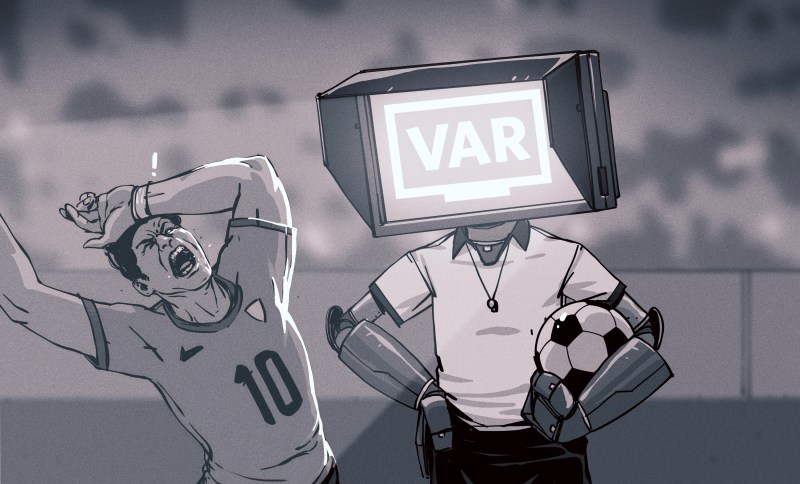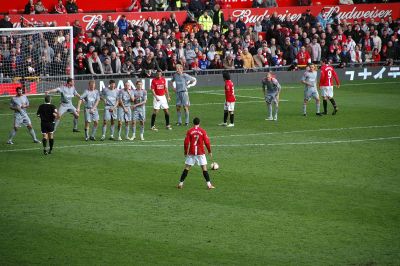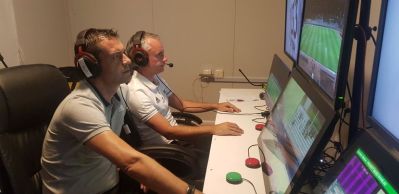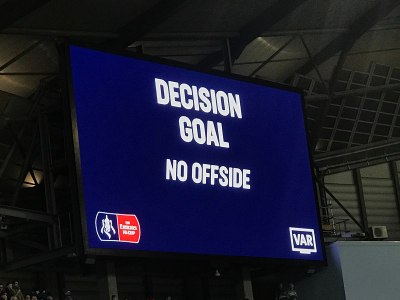

Another week in football, another VAR controversy to fill the column inches and rile up the fans. If you missed it, Coventry scored a last-minute winner in extra time in a crucial match—an FA Cup semi-final. Only, oh wait—computer says no. VAR ruled Haji Wright was offside, and the goal was disallowed. Coventry fans screamed that the system got it wrong, but no matter. Man United went on to win and dreams were forever dashed.
Systems like the Video Assistant Referee were brought in to make sport fairer, with the aim that they would improve the product and leave fans and competitors better off. And yet, years later, with all this technology, we find ourselves up in arms more than ever.
It’s my sincere belief that technology is killing sport, and the old ways were better. Here’s why.
The Old Days

For hundreds of years, we adjudicated sports the same way. The relevant authority nominated some number of umpires or referees to control the game. The head referee was the judge, jury, and executioner as far as rules were concerned. Players played to the whistle, and a referee’s decision was final. Whatever happened, happened, and the game went on.
It was not a perfect system. Humans make mistakes. Referees would make bad calls. But at the end of the day, when the whistle blew, the referee’s decision carried the day. There was no protesting it—you had to suck it up and move on.
This worked fine until the advent of a modern evil—the instant replay. Suddenly, stadiums were full of TV cameras that captured the play from all angles. Now and then, it would become obvious that a referee had made a mistake, with television stations broadcasting incontrovertible evidence to thousands of viewers across the land. A ball at Wimbledon was in, not out. A striker was on side prior to scoring. Fans started to groan and grumble. This wasn’t good enough!
And yet, the system hung strong. As much as it pained the fans to see a referee screw over their favored team, there was nothing to be done. The referee’s call was still final. Nobody could protest or overrule the call. The decision was made, the whistle was blown. The game rolled on.
Then somebody had a bright idea. Why don’t we use these cameras and all this video footage, and use it to double check the referee’s work? Then, there’ll never be a problem—any questionable decision can be reviewed outside of the heat of the moment. There’ll never be a bad call again!
Oh, what a beautiful solution it seemed. And it ruined everything.
The Villain, VAR

Enter the Video Assistant Referee (VAR). The system was supposed to bring fairness and accuracy to a game fraught with human error. The Video Assistant Referee was an official that would help guide the primary referee’s judgement based on available video evidence. They would be fed information from a cadre of Assistant Video Assistant Referees (AVARs) who sat in the stadium behind screens, reviewing the game from all angles. No, I didn’t make that second acronym up.
It was considered a technological marvel. So many cameras, so many views, so much slow-mo to pour over. The assembed VAR team would look into everything from fouls to offside calls. The information would be fed to the main referee on the pitch, and they could refer to a pitchside video replay screen if they needed to see things with their own eyes.

The key was that VAR was to be an assistive tool. It was to guide the primary referee, who still had the final call at the end of the day.
You’d be forgiven for thinking that giving a referee more information to do their job would be a good thing. Instead, the system has become a curse word in the mouths of fans, and a scourge on football’s good name.
From its introduction, VAR began to pervert the game of football. Fans were soon decrying the system’s failures, as entire championships fell the wrong way due to unreliability in VAR systems. Assistant referees were told to hold their offside calls to let the video regime take over. Players were quickly chided for demanding video reviews time and again. New rules would see yellow cards issued for players desperately making “TV screen” gestures in an attempt to see a rivals goal overturned. Their focus wasn’t on the game, but on gaming the system in charge of it.

VAR achieves one thing with brutal technological efficiency: it sucks the life out of the game. The spontaneity of celebrating a goal is gone. Forget running to the stands, embracing team mates, and punching the air in sweet elation. Instead, so many goals now lead to minute-long reviews while the referee consults with those behind the video screens and reviews the footage. Fans sit in a stunted silence, sitting in the dreaded drawn-out suspense of “goal” or “no goal.”
The immediacy and raw emotion of the game has been shredded to pieces. Instead of jumping in joy, fans and players sit waiting for a verdict from an unseen, remote official. The communal experience of instant joy or despair is muted by the system’s mere presence. What was once a straightforward game now feels like a courtroom drama where every play can be contested and overanalyzed.
It’s not just football where this is a problem, either. Professional cricket is now weighed down with microphone systems to listen out for the slightest snick of bat on ball. Tennis, weighed down by radar reviews of line calls. The interruptions never cease—because it’s in every player’s interest to whip out the measuring tape whenever it would screw over their rival. The more technology, the more reviews are made, and the further we get from playing out the game we all came to see.
Making Things Right

With so much footage to review, and so many layers of referees involved, VAR can only slow football down. There’s no point trying to make it faster or trying to make it better. The correct call is to scrap it entirely.
As it stands, good games of football are being regularly interrupted by frustrating video checks. Even better games are being ruined when the VAR system fails or a bad call still slips through. Moments of jubilant celebration are all too often brought to naught when someone’s shoelace was thought to be a whisker’s hair ahead of someone’s pinky toe in a crucial moment of the game.
Yes, bad calls will happen. Yes, these will frustrate the fans. But they will frustrate them far less than the current way of doing things. It’s my experience that fans get over a bad call far faster when it’s one ref and and a whistle. When it’s four referees, sixteen camera angles, and a bunch of lines on the video screen? They’ll rage for days that this mountain of evidence suggests their team was ripped off. They won’t get over it. They’ll moan about it for years.
Let the referees make the calls. Refereeing is an art form. A good referee understands the flow of the game, and knows when to let the game breathe versus when to assert control. This subtle art is being lost to the halting interruptions of the video inspection brigade.
Football was better before. They were fools to think they could improve it by measuring it to the nth degree. Scrap VAR, scrap the interruptions. Put it back on the referees on the pitch, and let the game flow.